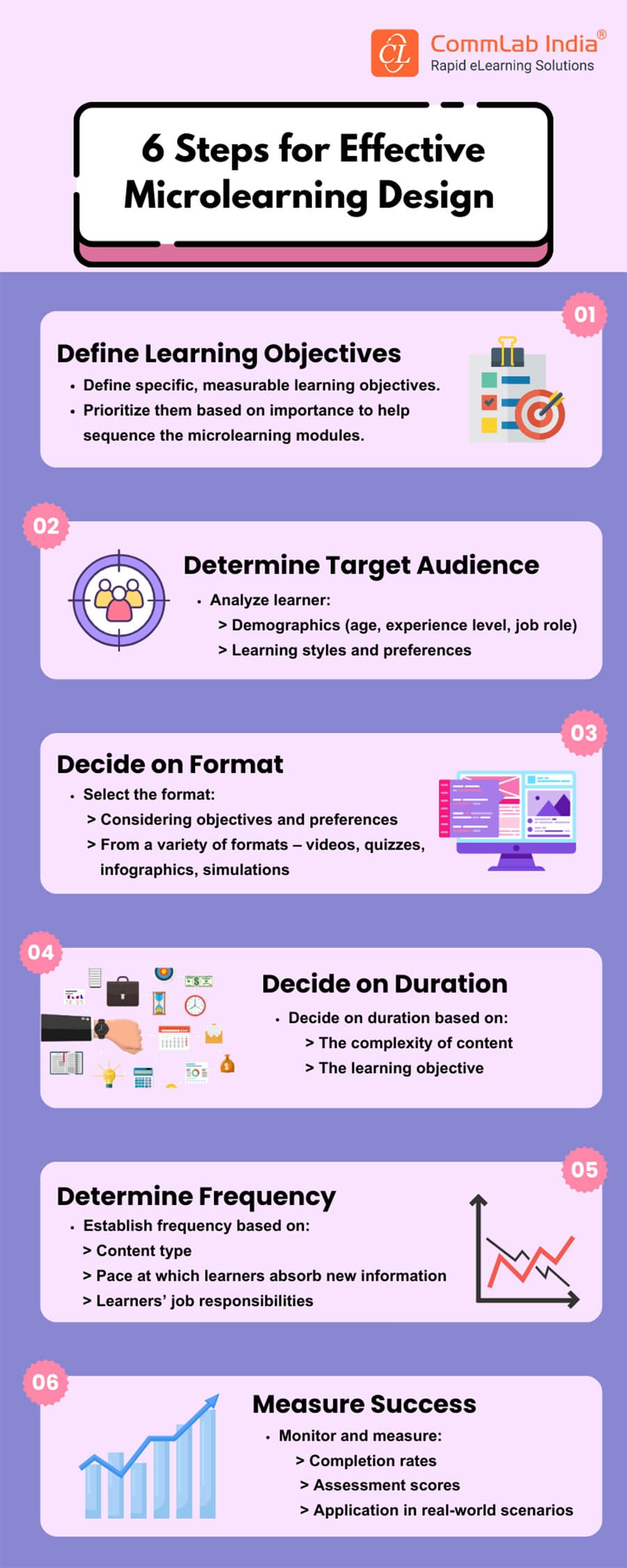What are the Steps for Effective Microlearning Design? [Infographic]
![What are the Steps for Effective Microlearning Design? [Infographic] What are the Steps for Effective Microlearning Design? [Infographic]](https://blog.commlabindia.com/hubfs/blogs/steps-effective-microlearning-design-info.jpg)
Ever zoned out a mid-eLearning course, staring at a wall of text and wondering if you'll ever learn anything? Yeah, me too. Let's face it, some online courses can feel like endless walks with no clear destination in sight. But, let’s not forget that knowledge is power. And with the right approach, learning can be fun and effective! The catchphrase is “right approach”. Wondering what it could be? Well, I’m talking about microlearning. This training method delivers information in small, focused nuggets.
In this blog, we’re going to get an overview of microlearning along with its benefits in corporate training and how you can ensure effective microlearning design. So without much delay, let’s begin.
What is Microlearning?
Microlearning refers to breaking down learning content into short, focused modules. These modules normally range between 7-15 minutes, focusing on a single learning objective or topic. Microlearning can be delivered in a variety of formats, like infographics, digital flashcards, videos, audio, interactive eBooks, quizzes, and more! All these aspects combine to maximize learning efficiency and boost information retention, thereby enhancing training ROI.
→ Download Now: Where Does Microlearning Fit in Your Learning Strategy?
Benefits of Microlearning in Corporate Training
Here's a list of some noteworthy benefits that help microlearning take center stage in corporate training:
Boosts Engagement and Retention
Short, focused bursts of information are easier to absorb and remember than lengthy lectures. Furthermore, microlearning incorporates interactive and multimedia elements like click-throughs, quizzes, audio, videos, animations, simulations, etc., that keep learners engaged and motivated. If the learners feel stuck or are unsure about a concept, they can revisit the concepts quickly which contributes to long-term retention and accurate concept application.
Saves Time
Employees are busy! Microlearning allows them to fit training into their schedules without disrupting their workflow. With microlearning, they can learn on the go, during breaks, or even while commuting. This helps them make the most of their time and enhance their productivity.
Knowledge on Demand
Microlearning modules are readily available online or on mobile devices. This allows employees to access specific training exactly when they need it, reinforcing knowledge application in real-time scenarios.
Ensures Cost-Effectiveness
Developing and delivering microlearning modules requires fewer resources compared to traditional training methods. Additionally, the shorter development cycles make it easier to update content as needed.
Promotes Continuous Learning
Learning is an ongoing process and microlearning helps you foster this culture of continuous learning. You can provide learners with continuous, bite-sized learning opportunities they need at any time or place. This empowers employees to take control of their professional development and stay up-to-date with industry trends.
6 Steps for Effective Microlearning Design
To Sum It Up!
With microlearning at your disposal, the future of corporate training is intelligent, efficient, and engaging. It comes across as a powerful solution that caters to the needs of today's busy workforce. By adopting this approach, you can transform your training programs from cumbersome roadblocks to springboards for continuous learning and employee growth. To make the most of microlearning, it’s important to understand where it fits properly in your learning strategy. Learn about it in the free eBook below.







![Microlearning Trends to Look Out For in 2024 [Infographic]](https://blog.commlabindia.com/hubfs/blogs/microlearning-trends-look-out-for-info.jpg)